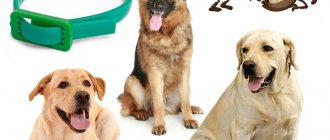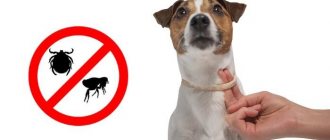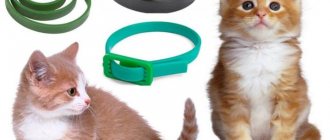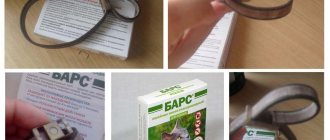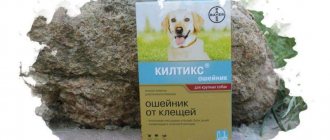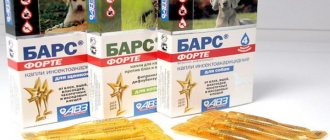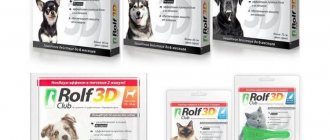If skin parasites begin to bother your beloved pet, then not only the animal, but also its owner feels depressed. You need to think about the means of protecting your pet in a timely manner. After all, the appearance of fleas and ticks can lead not only to unpleasant itching, but also to serious infectious diseases. In this article, we will look at what harm bloodsuckers can cause to an animal, what types of collars exist, as well as which flea and tick collar is best to choose for your dog, consider customer reviews and draw a conclusion about their effectiveness.
Consequences of flea bites
The dog scratches the affected areas, which often causes an allergic reaction. The substance that fleas inject under the skin has a negative effect on the hemostasis system, which is responsible for stopping bleeding. In addition, allergens contained in the secreted secretion can cause stomach diseases, as well as lichen and hair loss.
Ectoparasites carry tapeworms such as the cucumber tapeworm. It starts in the intestines of the animal and, as a parasite, releases toxic substances that can cause nervous disorders, nausea and refusal to eat. In severe cases, seizures and sudden weight loss are possible.
Sometimes fleas can lead to a deadly disease like rabies. You don’t have to be afraid of the virus if you get vaccinated in a timely manner.
Consequences of tick bites
To rid your animal of forest blood-sucking insects, you need to put a protective collar on your dog before walking in the park. An unprotected animal can be infected with the following diseases:
- piroplasmosis - provokes the destruction of blood cells;
- bartonellosis - leads to dysfunction of internal organs;
- borreliosis - can cause paralysis of certain parts of the body.
These diseases most often lead to death. This is why it is so important to protect your pet from ectoparasites in a timely manner.
There are many means of protection against pests, but flea and tick collars are considered the most effective and convenient to use.
Review of the most effective models: active ingredient, wearing rules
There are many brands of similar devices on the market, both domestic and foreign. The most popular among cat owners are Inspector, Dana Ultra, Insectal Plus, Bars, Celandine, Hartz, Bolfo, Foresto, Beaphar.
In order to reliably protect your pet from ectoparasites, before putting a flea collar on it, you must carefully study the instructions for its use, if not followed, it may be harmful to the animal.
Domestic collars: “Inspector”, “Dana Ultra”, “Insectal Plus”, “Bars” and “Clandestine”
The best domestic collars for combating ectoparasites in cats are “Inspector”, “Dana Ultra”, “Insectal Plus”, “Bars” and “Clandestine”. The devices of these brands differ from each other in composition. They are used as follows:
- open the packaging with the product;
- unroll the ribbon and put it around your pet’s neck;
- adjust the device to size - there should be a 1–1.5-centimeter gap between it and the cat’s neck;
- secure the clamp;
- cut off excess tape.
It is important not only how, but also how long to wear the collar. Constantly wearing such a device allows you to protect a kitten and an adult cat from ectoparasites for several months. It is recommended to put the product on your four-legged pet 2-3 days before expected contact with pests. Information about the most popular domestic brands of cat collars:
| Device name | Compound | Contraindications for use | Minimum age from which the collar can be used, months | Side effects | Consequences of overdose | |
| Active substance | Auxiliary components | |||||
| "Inspector" | Fipronil, pyriproxyfen, ivermectin | PVC-S-70-59-M, chalk, di-(2-ethylhexyl)-phthalate, epoxidized soybean oil, dye, food additives E171 and 572, tribasic lead sulfate | Pregnancy, lactation period, individual intolerance to the ingredients of the product | 2 | Hypersalivation, excessive lacrimation, skin irritation | Not found |
| "Dana Ultra" | Polyvinyl chloride, dioctyl phthalate, food additive E572, zinc stearate, epoxidized soybean oil, chalk, dye | Infectious diseases, recovery period after illness or surgery, increased sensitivity to the components of insectoacaricidal impregnation | Excessive salivation and lacrimation, indigestion, skin irritation | Depressed state, vomiting, muscle cramps | ||
| "Insectal Plus" | Fipronil, permethrin | Citronella oil, colorant, polymer | Infections, rehabilitation period, pregnancy, lactation, individual intolerance to components | 4 | Hypersalivation, excessive lacrimation, skin irritation | Not found |
| "Leopard" | Fipronil, diflubenzuron | Polyvinyl chloride, dioctyl phthalate, food additive E572, zinc stearate, chalk, dye, epoxidized soybean oil | Last third of pregnancy, lactation period, hypersensitivity to the ingredients of the product | 2 | Excessive salivation and lacrimation, skin irritation, muscle tremors, vomiting | |
| "Celandine" | Permethrin | PVC - S-70-59-M, chalk, di-(2-ethylhexyl)-phthalate, epoxidized soybean oil, pine fragrance, food additives E171 and 572, tribasic lead sulfate | Infectious diseases, recovery period after serious illnesses and surgery, pregnancy, lactation period, individual intolerance to the ingredients of the product | 4 | Hypersalivation, increased lacrimation, skin irritation | |
How does a tick and flea collar for dogs work?
A flea and tick collar is a protective product made of plastic or rubber, which is an elastic band that is fixed around the animal’s neck. The device has insecticidal properties and, upon contact with the dog’s skin, begins to release toxic substances that are smoothly distributed throughout the body. After about two days of using the collar, the “inhabited” blood-sucking parasites and their larvae die, and new “potential neighbors” are repelled by the repellents included in the composition. The service life of the device is from 4 to 7 months.
Continuous use of this collar will reliably protect your beloved pet from fleas and ticks. The main thing is to carefully read the instructions and safety precautions before use to avoid unpleasant consequences.
Contraindications and rules of use from the instructions:
- It is not recommended to wear an anti-flea collar on sick, pregnant or weakened animals, as well as pets under two months of age;
- during the first hours of wearing, the dog must be supervised, as individual intolerance or allergies are possible, in which case the collar must be removed immediately;
- the product should not lie next to food, things and other interior items;
- the storage location must be inaccessible to children and animals;
- It is necessary to exclude the possibility of the collar getting into the oral cavity, as this can cause disorders of the digestive and nervous systems. If this happens, you should immediately contact your veterinarian.
Benefits of flea and tick collars
If you follow certain rules of use, the protective collar will become a reliable barrier against blood-sucking parasites. In addition, it has significant advantages over other insecticidal agents:
- the product is affordable and, when used correctly, does not cause discomfort to the dog;
- innovative models of collars can protect the animal from various types of blood-sucking insects;
- modern devices are multifunctional and are used both to get rid of parasites and to prevent their occurrence;
- A new generation insecticidal device contains chemicals that are harmful to fleas and ticks, but safe for pets.
When getting rid of skin insects, the combined use of repellent products will be more effective. And in the future, it is necessary to remember that it is much easier to protect the animal in time than to later suffer with the removal of blood-sucking parasites.
Tips for use
- When choosing a collar for your cat, be sure to pay attention to the size indicated on the package. Usually it is universal, about 30 cm, but if the packaging says “for kittens”, the collar may be too short for an adult cat.
- The collar should be put on a few days after treatment with other medications, such as flea drops or after washing with shampoo.
- You cannot skimp on the health and safety of your pets, including cutting a large collar and dividing it between several cats. Remember that dog collars may not fit your cat!
- It is important to note the date you started using the product and calculate the time when the collar will need to be replaced (in accordance with the instructions).
- Insectoacaricidal collars need to be stretched a little before use in order to improve the release of substances from the pores of the plastic tape (the need for this action should be indicated in the instructions). A biological product does not require such manipulations. The ultrasonic collar must be turned on and set to the appropriate mode.
- To provide your pet with not only protection from insects, but also comfort, you need to adjust the collar to size. The retainer is secured so that there is a gap of 1 cm between the neck and the tape (an average finger thickness). This way the collar will not put pressure, and the risk of the animal taking it off or getting caught on something will be reduced. Excess tape is cut off. The end of the tape after the clamp should be no more than 1.5–2 cm long.
How to choose the right flea and tick collar
To choose a comfortable protective equipment for your pet, you need to study in detail the classification and size range of protective collars.
There are the following types of collars:
- Biological - more natural. Suitable for young puppies or dogs recovering from illness, as well as for females during pregnancy, as they contain plant extracts. Efficiency is average.
- Ultrasonic - odorless. This type of protection is harmless and universal. The action of such devices is based not on insecticidal properties, but on the sending of ultrasonic waves.
- Chemical ones are the most effective. They are recommended for completely healthy and adult dogs, as they contain a high concentration of toxic substances that are fatal to fleas, ticks and other parasites.
In addition to classification by species, there is a division by size of animals depending on the length of the collar:
- For small dogs of breeds such as Spitz, Chihuahua, lapdog, dachshund and many varieties of terriers, a collar up to 38 cm in length is suitable.
- For medium-sized pets, the representatives of which are: bulldog, husky, bull terrier, collie, husky, poodle, you need a product with a length of at least 58 cm.
- For large dogs: mastiff, Doberman, St. Bernard, German and Caucasian shepherd - a protective tape of 70 cm is intended.
Having decided on the type of product and measuring the volume of the dog’s neck, you can go shopping for a protective accessory.
When choosing a device, you should also consider the following factors:
- Composition and active ingredients. Manufacturers who have nothing to hide indicate this information.
- Cost of the collar. A cheap product may have questionable contents that are dangerous for your four-legged friend.
- Manufacturer. It is better to choose brands that have been tested by time and customers and have positive reviews.
You need to approach the purchase of protective equipment responsibly, having studied in detail all the characteristics and recommendations for using the product, so that your pet is as comfortable in a collar as without it.
Best GPS Collars for Cats
Collars with a GPS tracker are especially necessary for pets that walk independently. The devices allow you not only to see the current location of the cat, but also to study its habits, routes and behavioral characteristics. As a rule, collars are quite expensive, but provide the owner with ample opportunities: to issue a voice command remotely, set boundaries and receive a notification if the animal has crossed them, and much more. For correct operation, you need to install the application and purchase a SIM card for the collar.


